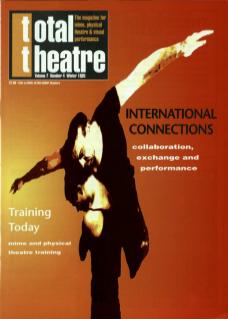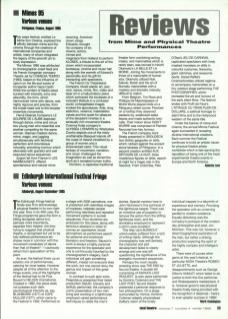This years festival, entitled Le Mime Son Cinéma, explored the affinity between mime and the cinema through the creations of international companies and artists, many of whom integrated the legacy of the seventh art to body expression.
The Mimos 1995 was attributed to choreographer Josef Nadj and his French Hungarian company Theatre Jel for Comedia Tempio (1990), based on the influence of opium on the life and works of Hungarian author Geza Csath. While the content of Nadj's piece bursted with intensity, irony and absurdity, the form, which harmonised mime with dance, was highly rigorous and precise, from the tiniest head nod to the broader ensemble movements.
Hervé Diasnas Company's Le Sourire de l’Aube depicted through dance, mime and circus two young men who resemble one another competing for the same woman. Diasnas masters dance, mime, magic and juggling simultaneously with technical perfection and clownesque virtuosity, provoking humour which alternates with graceful and well executed dance sequences.
Zygom'art from France in Les Marmousets offered spontaneous and natural mime clowning. American clown Jango Edwards, brought his company of six clowns, actors, mimes and magicians from Holland to perform Klones, a tribute to the art of the clown which incorporated burlesque, cinema and music hall along with the warmth of Edwards’ personality and his gift for interacting with spectators.
The French Ox Theatreland Company mixed plastic art, jazz, rock, dance, mime, film, video and laser art in a hallucinatory piece which portrayed the excesses of a turbulent lifestyle in a confused world. Unforgettable images evoked the apocalypse, AIDS, drug addiction, violence, materialistic values and the quest for pleasure of the decadent nineties in a sensually rich movement theatre. Cosmos Kolej company's Ulysse à l'envers by Wladyslaw Znorko depicts one of the misty unattainable Blasquet Islands off the coast of Ireland inhabited by a group of women and a shipwrecked sailor. This visual fantasy of movement, narration and music challenged the imagination as well as stirred the spirit as it revealed human truths.
Dondoro, a Japanese traditional theatre form combining acting, masks, and marionettes which is rarely seen, was revived in Hoichi Okamoto's La Belle et la Moine. Joining his movements to those of a marionette of human size, Okamoto utilised Noh, Kabuki, Butoh and the art of Bunraku marionettes with a mastery and dramatic intensity difficult to match.
From Belgium, Tim Roos and Philippe De Maertelaseere of Wurre Wurre played birds on a Périgueux street comer. Perched on a rooftop they observed passers-by, swallowed salad leaves and made authentic bird calls. Their indoor show Don’t Wurre was comprised of Flemish flavoured low-key humour.
The French company Hors Strate presented in Groudeck two Gothic gargoyles on stilts which rubbed against the ancient stone facades of Périgueux. In a second creation entitled Aux Detours de la Nuit, three mysterious figures on stilts search at night for a magic star in the heavens. From Colombia, Palo Q'Sea's Jeu de Carnival captivated spectators with lively masked monsters on stilts in colourful costumes, fireworks, giant ostriches, and awesome devils. Daniel Raffel's Cinémarionettes utilised ragtime to accompany marionettes on a tiny outdoor stage performing The Photographer, which recreated the art and humour of the early silent films. The festival ended with Profil de Face's L'Attaque du Train Plein de Dollars, a satirical homage to silent films and to the Hollywood western of the same title.
Under the banner of mime and cinema, the annual Mimos Festival again succeeded in revealing diverse international creations. Each summer the Festival continues to build an artistic haven for physical theatre artists worldwide which is fast earning the reputation of being one of the most experimental theatre events in Europe and North America.

